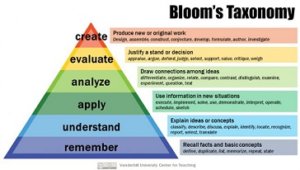 Oftentimes, when instructional designers are tasked with designing a course, one of the challenges that they face has to do with the design approach they take. While experienced instructional designers seem to have a better grasp of this, novices often struggle with selecting the right activities and exercises that truly reinforce learning.
Oftentimes, when instructional designers are tasked with designing a course, one of the challenges that they face has to do with the design approach they take. While experienced instructional designers seem to have a better grasp of this, novices often struggle with selecting the right activities and exercises that truly reinforce learning.
One of the best (and probably easiest) approaches to figure out the activities for the course is to use Bloom’s Taxonomy. Since Bloom’s taxonomy was created for traditional classroom training, there was a need to reconstruct it to fit modernized approaches to training. Therefore, in 2009, the Taxonomy was repackaged to reflect current needs.
In this blog post, I want to take a brief look at the repackaged Taxonomy, and see how instructional designers can apply it to their eLearning and Blended learning courses.
The best way to use Bloom’s taxonomy is to use the content of the course to develop measurable learning objectives. Then, categorize these objectives based on the levels of learning and include appropriate activities in each category.
Remembering is the first level of learning. It simply refers to being able to remember concepts to become familiar with them.
Some of the activities that instructional designers can use at that level include PDF attachments, step-by-step lists, and webinars.
The next level of learning is known as Understanding. This level can be tricky, mostly because we all know that understanding can’t be measured, and therefore, we should avoid using that “term” in learning objectives. However, similar to Remembering, Understanding is one of the foundational levels of learning and can be taught through lectures, step-by-step user guides, PDF files, and by incorporating the Click and Drag activities using rapid eLearning tools such as Articulate and Captivate.
Applying is the next level of learning. This is where learners take the concepts from the first two foundational levels and start doing something. While this level of learning works best in a classroom setting, where people can form small groups and carry out conversations, it is possible to do it through virtual classrooms, discussion boards, or by offering learners to complete a simulation.
The next level of learning is known as Analyzing. While activities for Applying can be easily developed and evaluated, Analyzing requires a lot of work. These activities are very time and resource consuming and, in most cases, can’t be evaluated in a virtual environment.
Therefore, if you want your learners to be able to analyze something, you may want to consider a blended learning approach with, at least, a discussion board available to them.
The Evaluation level of learning also works best in a blended environment; however, it can be achieved through asynchronous eLearning as well. At that level, you want learners to be able to make decisions about things through researching and evaluating their options. This can be done through such activities as scavenger hunts and web searches.
Create is the last level of learning. This is where learners physically do or create something they have learned in class using all the resources available to them. Clearly, Creating works best in a classroom setting, but, if you must do your training in the eLearning format, consider a blended learning approach with a discussion board, a forum, or even access to a conference line. You can also use a Webcam or ask learners to record a short video with their smartphones showing the steps they take to complete the required task.
Note, that not all courses will require you to have objectives for all levels of learning. However, if you are new to instructional design, Bloom’s Taxonomy should help you figure out the best presentation methods of the material.
If you want to start creating successful eLearning courses, join my Instructional Design for ELearning program. This comprehensive program contains more than 10 hours of video content, lots of supplementary materials, templates, and Articulate 360 and Captivate step-by-step guides. I am offering a $100 discount for a limited time! Sign up now, because the price will definitely go back up!

When utilizing Bloom Taxonomy for ELearning I am particularly interested in how and if they APPLY the knowledge. I try to have to participants response to a quick survey (2-3 questions) to see if the are on track
Love the idea of using the students’ phones to create a video! Thanks for this concise resource. This has also proved helpful to our subject matter experts who are often called upon to help develop lesson activities but are not necessarily trained instructional designers.